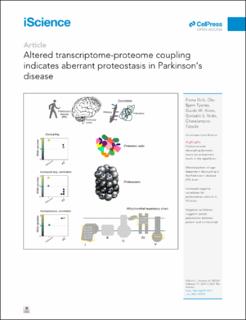| dc.contributor.author | Dick, Fiona | |
| dc.contributor.author | Tysnes, Ole-Bjørn | |
| dc.contributor.author | Alves, Guido Werner | |
| dc.contributor.author | Sanchez Nido, Gonzalo | |
| dc.contributor.author | Tzoulis, Charalampos | |
| dc.date.accessioned | 2023-05-24T12:15:28Z | |
| dc.date.available | 2023-05-24T12:15:28Z | |
| dc.date.created | 2023-04-18T09:44:50Z | |
| dc.date.issued | 2023 | |
| dc.identifier.citation | Dick, F., Tysnes, O. B., Alves, G. W., Nido, G. S., & Tzoulis, C. (2023). Altered transcriptome-proteome coupling indicates aberrant proteostasis in Parkinson’s disease. iScience, 26, 105925. | en_US |
| dc.identifier.issn | 2589-0042 | |
| dc.identifier.uri | https://hdl.handle.net/11250/3068840 | |
| dc.description.abstract | Aberrant proteostasis is thought to be implicated in Parkinson’s disease (PD), but patient-derived evidence is scant. We hypothesized that impaired proteostasis is reflected as altered transcriptome-proteome correlation in the PD brain. We integrated transcriptomic and proteomic data from prefrontal cortex of PD patients and young and aged controls to assess RNA-protein correlations across samples. The aged brain showed a genome-wide decrease in mRNA-protein correlation. Genes encoding synaptic vesicle proteins showed negative correlations, likely reflecting spatial separation of mRNA and protein into soma and synapses. PD showed a broader transcriptome-proteome decoupling, consistent with a proteome-wide decline in proteostasis. Genes showing negative correlation in PD were enriched for proteasome subunits, indicating accentuated spatial separation of transcript and protein in PD neurons. In addition, PD showed positive correlations for mitochondrial respiratory chain genes, suggesting a tighter regulation in the face of mitochondrial dysfunction. Our results support the hypothesis that aberrant proteasomal function is implicated in PD pathogenesis. | en_US |
| dc.language.iso | eng | en_US |
| dc.publisher | Elsevier | en_US |
| dc.rights | Navngivelse 4.0 Internasjonal | * |
| dc.rights.uri | http://creativecommons.org/licenses/by/4.0/deed.no | * |
| dc.title | Altered transcriptome-proteome coupling indicates aberrant proteostasis in Parkinson's disease | en_US |
| dc.type | Peer reviewed | en_US |
| dc.type | Journal article | en_US |
| dc.description.version | publishedVersion | en_US |
| dc.rights.holder | The authors | en_US |
| dc.subject.nsi | VDP::Medisinske Fag: 700 | en_US |
| dc.source.pagenumber | 21 | en_US |
| dc.source.volume | 26 | en_US |
| dc.source.journal | iScience | en_US |
| dc.source.issue | 2 | en_US |
| dc.identifier.doi | 10.1016/j.isci.2023.105925 | |
| dc.identifier.cristin | 2141497 | |
| cristin.ispublished | true | |
| cristin.fulltext | original | |
| cristin.qualitycode | 1 | |

